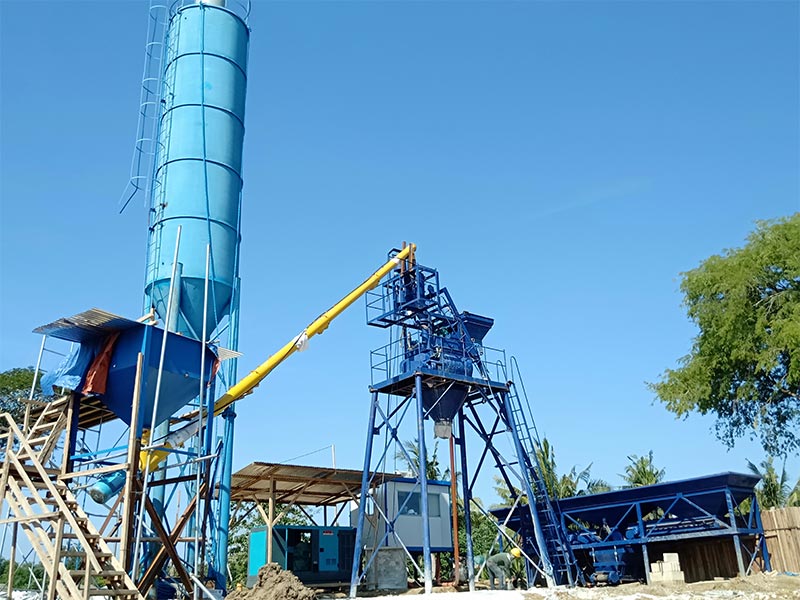How do you choose the right skip hoist concrete batching plant for your project?
When selecting a skip hoist concrete batching plant, it’s crucial to make the right choice to ensure your project runs smoothly and efficiently. These plants are essential for construction projects where concrete is mixed in a centralized location and transported for use. With various models and features available, choosing the best one for your needs can be challenging. This guide will walk you through key considerations to help you make an informed decision.
Basics of a Skip Hoist Concrete Batching Plant
A skip hoist concrete batching plant utilizes a bucket (skip hoist) to lift the raw materials to the mixing unit. This type of plant is preferred for small to medium-sized construction projects due to its compact design and efficiency. Understanding how this plant operates will help you assess its suitability for your project.

Advantages of Skip Hoist Batching Plants
Compact footprint: These plants occupy less space compared to other batching plants, making them ideal for projects with limited site area.
Efficient material handling: The skip hoist mechanism allows for quick and efficient transfer of materials to the mixer.
Lower initial investment: Typically, these plants require a lower upfront investment compared to belt conveyor plants, making them cost-effective for smaller projects.
Assess Your Project’s Scale and Requirements
One of the first things to consider when choosing a skip hoist type concrete batching plant is the size of your project. The plant’s capacity should align with the amount of concrete you need to produce on a daily basis.
Matching Capacity to Project Size
Small-scale projects: For residential construction or small commercial projects, a plant with a capacity of 25-35 cubic meters per hour may be sufficient.
Medium-scale projects: Larger commercial or industrial projects may require a plant with a capacity of 50-75 cubic meters per hour.
If your project requires a high volume of concrete on a tight schedule, ensure the plant can handle the demand without causing delays.
Evaluate the Layout and Space Constraints
The physical space available at your project site is another critical factor. Skip hoist plants are known for their compact designs, which can be advantageous when space is limited. However, you’ll still need to ensure the plant can be set up without obstructing other activities on-site.
Considerations for Site Layout
Vertical clearance: Ensure there’s adequate height for the skip hoist to operate smoothly.
Proximity to the construction site: Positioning the plant close to where the concrete is needed can reduce transportation time and costs.
Taking these factors into account will help you avoid unnecessary setup complications or operational bottlenecks.
Examine the Control System and Automation Features
A modern skip hoist concrete plant should come equipped with a user-friendly control system. Automated control systems can greatly improve the efficiency of your operations by reducing manual input and ensuring consistent quality.
Benefits of Automation
Improved precision: Automated systems help ensure the correct proportions of raw materials are used, reducing waste and ensuring high-quality concrete.
Time savings: Automation speeds up the batching process, allowing you to meet tight project timelines.
When choosing a plant, look for models with advanced control panels that are easy to use and capable of storing multiple mix designs.
Factor in Maintenance and Durability
Lastly, consider the long-term durability of the plant and its components. Regular maintenance is essential to ensure the smooth operation of your skip hoist concrete batching plant, but selecting a model known for its reliability will reduce downtime and costly repairs.
Tips for Ensuring Longevity
Quality of materials: Opt for a plant constructed from high-grade steel and corrosion-resistant materials to withstand harsh working conditions.
Availability of spare parts: Ensure that spare parts for the plant are readily available to avoid long downtimes during repairs.
Selecting a plant that is easy to maintain will save you time and money in the long run.
Conclusion
Choosing the right skip hoist concrete batching plant for your project involves assessing your specific needs, such as project scale, site layout, automation requirements, and long-term maintenance. By carefully considering these factors, you’ll be better equipped to select a plant that meets your project’s demands, ensuring smooth operations and timely completion. Whether you’re working on a small residential project or a large commercial build, the right batching plant will make all the difference in achieving success.

评论
发表评论